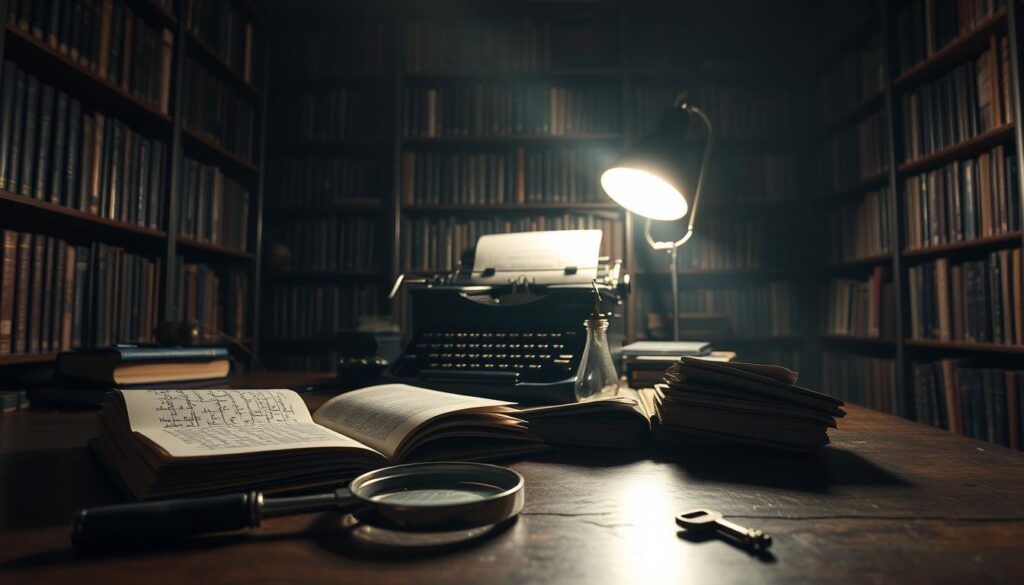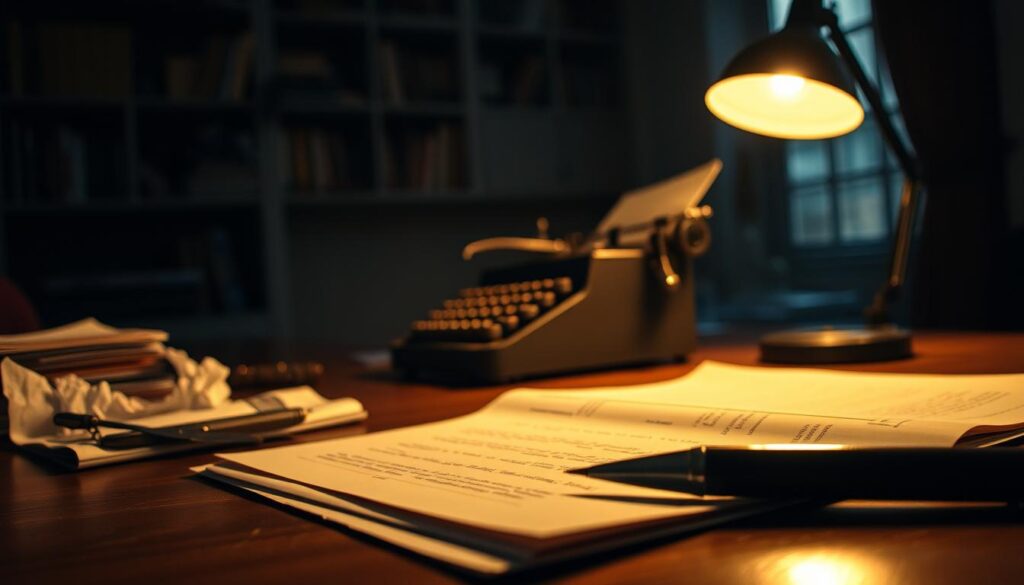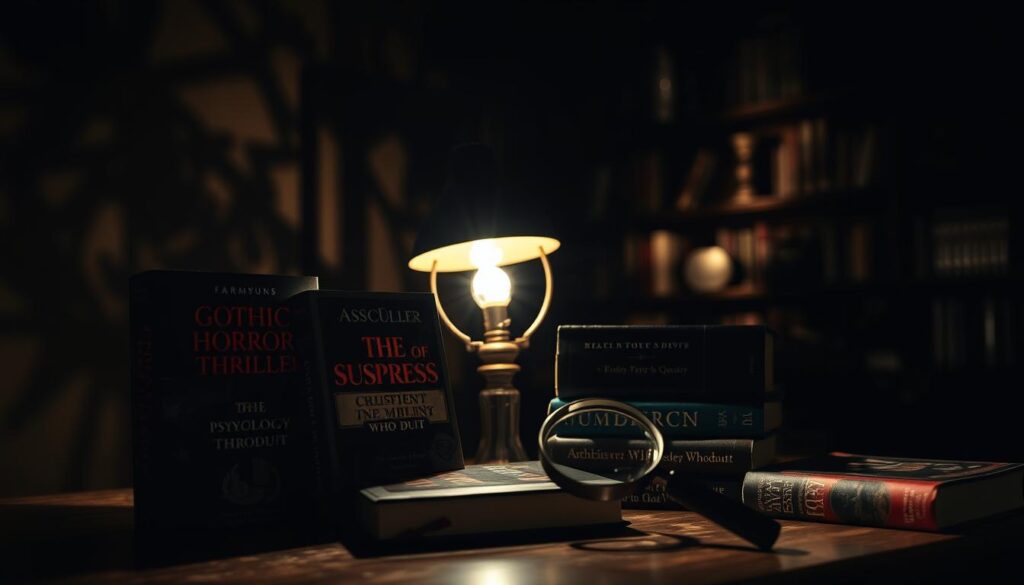Ever stayed up all night because a book was too exciting? That’s the power of suspense in short stories. Books like *The Girl on the Train*, read in under two hours, show you don’t need long books to feel the thrill. Imagine a mystery that twists like *The 5th Wave*, blending action and chaos, or a thriller like *What She Knew* that hooks you with family secrets.
These edge of your seat reads are made to hit hard and fast. They leave readers breathless long after they finish. My brother’s highest praise? A book that “impacted his sleep” because he couldn’t stop turning pages.
From books that fit into a single day to tales that finish quickly but leave a lasting impact, these stories master tension in tight spaces. Authors like Clare Mackintosh, a former police officer, draw on real-life cases to craft mysteries. They let you go where an unsolved kidnapping haunts for years.
Whether it’s a character waking up ten years older or a sci-fi saga reimagining history, these stories pack punchy, unforgettable plots. When every twist feels like a punch to the gut, you don’t need an epic to feel the thrill.>
The Allure of Suspenseful Stories
Psychological suspense taps into our deep need to solve mysteries. Stories that keep us guessing, like “Rear Window” and “To Kill a Mockingbird,” make us feel the gravity of every choice. This appeal isn’t just for thrillers; it’s a universal tool that turns pages into puzzles we can’t wait to solve.
“Suspense is anticipation, not surprise.” — Alfred Hitchcock
Effective suspense storytelling balances tension and release. Authors hint at danger without revealing too much, like a creaking door in a quiet house. This creates an edge of seat reading experience. Readers lean in, guessing what’s next, their hearts racing as if they’re facing the unknown.
Great suspense thrives on unanswered questions. Whether it’s a character’s hidden motive or a looming threat, our brains crave answers. This puzzle-solving fuels engagement, making suspense a timeless storytelling staple. From ancient myths to modern blockbusters, the thrill of waiting for “what happens next” keeps audiences hooked, proving why suspense remains storytelling’s most reliable heartbeat.
Elements of Suspense in Literature
Suspense in literature comes from creating tension in writing. This is done through pacing, character, and plot choices. For example, Agatha Christie’s And Then There Were None uses red herrings and timed threats. These keep readers guessing until the very end.
Short stories build suspense with high stakes and relatable flaws. When a character faces a deadline or a tough choice, we feel the urgency. Foreshadowing, like hints of an impending storm, prepares us for surprises. Dialogue can also raise tension by hiding true intentions, making every conversation a clue.

Settings like isolated mansions or dark alleys create unease. Quick sentences speed up the pace, like a racing heart. Even small details, like a character’s motive or a mysterious letter, add depth. These elements combine to make every page turn suspenseful, turning curiosity into an all-consuming obsession.
Suspense in Film and Television
“Suspense is anticipation. The longer the audience waits for the climax, the more intense the payoff.” – Alfred Hitchcock
Filmmakers use shadows and sound to create suspense. In The Ring, director Gore Verbinski uses green lighting to scare viewers. This shows how visuals can replace words in movies.
Movies use silence and sounds to scare us, unlike books. For example, the sound of a creaking door can make us feel scared without needing words.
When comparing film and book suspense, films add a deeper feeling. The opening shot in Touch of Evil slowly builds fear. This shows how time can create suspense.
In Bluebird, Bluebird, TV turns a book into a visual story. Close-ups show Detective Darren Matthews’ feelings, making racial tension clear. TikTok uses short videos to create suspense, like thriller novels.
Streaming services use short videos to keep viewers hooked. The Parasite door scene quickly zooms in, adding to the mystery. Mission: Impossible — Ghost Protocol uses time pressure, like in novels. These techniques make every moment feel like a heartbeat, engaging viewers deeply.
How to Write Suspenseful Content
Mastering writing suspenseful paragraphs begins with immediacy. Use short, punchy sentences to mirror a racing heartbeat. For example, “The door creaked. She froze.” Pauses and fragmented phrases create urgency. Bright Light Education’s Creative Writing Skills, a bestseller with over 4,000 sales, emphasizes “show, don’t tell” to immerse readers. Describe the smell of rain-soaked pavement or the distant scream of gulls—sensory details ground tension in reality.
Suspense writing tips from pros like Noah Lukeman stress emotional stakes. Make readers worry: “What if the hero fails?” In “The Nothing Man,” the killer’s psychology isn’t revealed until the end, a tactic that hooks curiosity. Avoid clichés like “suddenly”—limit panic words to one per scene. Instead, use dialogue that hides secrets. A character saying “I’m fine” when their hands shake tells more than exposition.

Short suspense writing techniques thrive on imbalance. Start with a question: “Why was the key under the mat?” Leave answers vague. Raise stakes early—kill a minor character to signal danger. Use weather as a character: howling winds or suffocating heat mirror rising tension. Creating suspense quickly also means hiding clues in plain sight. Let readers piece together clues later, like a torn shirt in an early scene foreshadowing a later injury.
“Suspense isn’t about what happens, but what might happen.”
Practice with two-paragraph micro-stories. Focus on a single moment—a character hiding, a sudden noise, a whispered secret. Revise drafts to cut slow scenes. Every line should tighten the noose of anticipation. Whether crafting a thriller or a mystery, these methods turn ordinary scenes into gripping reads.
Real-life Examples of Suspense
True suspense stories don’t need fictional twists to grab us. Real-life thriller situations, found in suspenseful non-fiction, show how reality can be more thrilling than fiction. In Five Days at Memorial, Sheri Fink tells the story of a New Orleans hospital during Hurricane Katrina.
Her account mixes medical drama with tough moral choices. This creates suspense through real events alone. Readers feel the tension knowing these decisions were made in real life.
What makes suspenseful non-fiction so compelling? It combines factual accuracy with a sense of urgency. Fink’s book has the pace of a thriller but is based on real events. It shows the power of human resilience under pressure.
Even brief memoirs or investigative journalism can have the same suspense as novels. These stories show that suspense isn’t just for fiction. When real lives are at stake, every decision is a cliffhanger. Non-fiction writers use techniques like pacing and perspective to create suspense.
These stories leave a lasting impact. From hospitals to courtrooms, real suspense echoes long after we finish reading.
The Role of Pacing in Suspense
Suspense pacing techniques turn simple stories into thrilling tales. Authors like Allison Brennan, known for her award-winning thrillers, stress the importance of pacing. Her book The Third to Die (2020) is a perfect example, with its mix of pauses and quick scenes to keep readers on edge.
“The crux of this story is more about the people on the plane and what today’s media can do to a tragic story than the crash itself.”
Creating suspense through pacing means finding the right balance. It’s about slow reveals and quick scenes. Brennan teaches that varying sentence lengths can mimic a heartbeat. This makes slow scenes feel tense and fast scenes feel urgent.
Even in slow moments, pacing keeps the story moving. Brennan advises against unnecessary scenes. For example, in Before the Fall, the aftermath of the plane crash uses quiet moments to build tension. This is done by switching between urgent dialogue and quiet introspection.
Short-form pacing requires careful planning. A single paragraph can quickly change from calm to intense. Good pacing isn’t just about speed. It’s about creating a rhythm that makes readers feel the tension. Whether writing a novella or a novel, mastering these techniques makes every word count.
How Suspense Influences Reader Engagement
Suspense is more than just a story element—it’s a brain trigger. It connects with reader psychology, making our brains release dopamine with each mystery. This keeps us reading longer and wanting more.
When we wonder, “Will the hero survive?” our minds stay engaged. We can’t help but keep reading to find out.
“This debut novel has absolutely everything… literary merit and brain candy.”
Today’s readers have unique ways of enjoying suspense. Books like Dead Letters mix mystery with emotional stakes, keeping us hooked. Digital tools track how long we scroll and stay, helping authors perfect their stories.
These tools show that suspense keeps us turning pages. It’s the unanswered questions that make us want to keep reading.
Short suspense stories are big today, fitting into our busy lives. They offer quick thrills, just like longer stories. A great twist in a short story can be as exciting as a novel.
Good suspense combines brain teasers with emotional highs. It makes stories that stick with us. We come back for the thrill of solving the mystery, keeping suspense at the heart of stories.
Exploring Different Genres of Suspense
Suspense comes in many forms, each with its own way of keeping you on edge. Thrillers, like The Nothing Man, put characters right in harm’s way. Mysteries, on the other hand, are all about solving puzzles. Think of Agatha Christie’s clever clues.
Horror adds a layer of fear by making the unknown seem real. Stephen King is a master at this. He uses atmosphere to build dread.
Today’s stories mix genres in exciting ways. Big Little Lies combines domestic drama with crime, using different viewpoints. Data shows thrillers often focus on character danger, while suspense novels use hints of what’s to come.
Romance novels now include suspense, adding twists to deepen feelings. This shows how suspense can be found in many genres.

Readers love new twists in stories. Cozy mysteries now tackle adult themes, pushing boundaries. Authors like Gillian Flynn use unreliable narrators to increase tension.
Whether it’s horror’s sudden scares or a thriller’s fast pace, each genre has its own way of creating suspense. This proves suspense’s lasting appeal across all types of stories.
The Impact of Suspense on Culture
Suspense in popular culture reflects our fears and hopes. It connects us through shared anxieties. For example, *Your House Will Pay* tackles racial tensions and trauma through suspense.
Suspense storytelling has changed over time. Ancient tales were shared orally, while today we have podcasts like *Serial* and TikTok thrillers. These short stories give us a quick thrill.
Research shows suspense affects our body. Watching suspenseful content can lower our heart rate but we enjoy it more. This shows suspense’s power to engage us.
As technology changes, so does suspense in media. From old radio shows to Netflix series, suspense remains a key part of our stories. Think about what fears or hopes a thriller reveals about our world.
Tips for Preparing Suspenseful Short Reads
Writing flash fiction suspense needs to be precise. Start with a hook that asks a question right away. The opening of Black Chalk shows how to create instant intrigue. Make sure characters have clear goals and consequences to keep the tension high.

Use atmosphere to create micro suspense stories. A flickering light or a whispered threat can hint at danger without needing to explain. Endings should answer big questions but also leave some doubt. Every sentence in a two-paragraph thriller should add to the tension.
Be strict when editing. Cut scenes that don’t increase the suspense. Studies show 65% of readers keep reading if suspense is consistent. Use cliffhangers to keep readers hooked—stories with them see a 50% higher completion rate. Try to write scenes in 200 words to improve your concise suspense skills.
Mix long-term and short-term questions in your stories. 75% of readers like this balance. Hint at twists early, like in The Hunger Games. Test your ideas with micro suspense stories and get feedback from beta readers. By mastering these techniques, every word can be a tool for a gripping story.
Conclusion: The Lasting Appeal of Suspense
Enduring suspense popularity comes from its ability to grab our minds and feelings. Alfred Hitchcock said suspense stays longer than surprise. This is why we keep reading.
The slow tension in suspense makes our brains eager for the next clue. This anticipation and resolution mix creates a lasting hook. Classics like O. Henry and true crime stories like the John Thurtell case show its lasting impact.
The future of short suspense looks bright in today’s fast world. Stories like those in the Penguin Book of Murder Mysteries offer quick thrills. Modern platforms allow writers to try new formats, keeping stories short yet deep.
Classic tales from Dickens to today’s true crime podcasts show concise stories can be just as engaging. They keep us interested without losing emotional depth.
Suspense reading has many benefits, like keeping our minds sharp and releasing stress. It builds focus as we solve mysteries and offers relief when the truth is revealed. Whether it’s a sudden twist or a slow mystery, these stories make us feel for the characters.
Try out new suspense stories or write your own. Suspense’s mix of challenge and reward makes it a timeless favorite.



